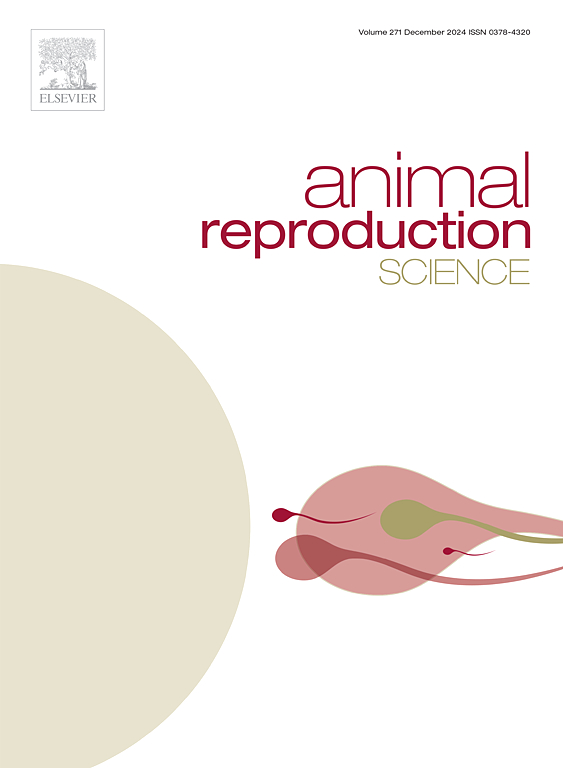地塞米松对妊娠山羊的影响:新生山羊的活力、热成像、生理反应和行为模式
IF 3.3
2区 农林科学
Q1 AGRICULTURE, DAIRY & ANIMAL SCIENCE
引用次数: 0
摘要
围产期死亡给山羊生产造成经济损失,引产已成为生产者计划产程从而提高新生儿存活率的一项关键战略。本研究的目的是评估妊娠山羊给药地塞米松对新生山羊活力、热成像特征、生理反应和行为模式的影响。选取36只多产法国高山山羊及其后代,随机分为3组:G1组为对照山羊;G2,在分娩前36 h肌内注射0.9% %生理盐水溶液;G3组在预计分娩日期前肌肉注射16毫克地塞米松36 h。在实验中,评估了分娩持续时间、驱逐间隔、第一次梳理的潜伏期、嗅探、表面温度和母子关系。在儿童中,在出生时、第一次哺乳后和产后24 h时评估活力、新生儿行为、血糖和乳酸水平、氧饱和度、出生体重和体表温度。与未接受地塞米松治疗的山羊相比,接受地塞米松治疗的山羊出生的孩子表现出更好的活力参数,特别是在哺乳反射方面(P <; 0.0001)以及正常的氧合和葡萄糖水平。此外,地塞米松处理的母鼠表现出更好的母性行为。我们得出的结论是,给自然交配的山羊注射16毫克剂量的地塞米松可以改善母子关系,并使出生的山羊具有更高的体表温度、充足的氧合水平和更高的哺乳反射百分比。本文章由计算机程序翻译,如有差异,请以英文原文为准。
Effect of the administration of dexamethasone in pregnant goats: Vitality, thermography, physiological response, and behavioral patterns of newborn kids
Perinatal deaths cause economic losses in goat production, and birth induction has emerged as a key strategy for producers to plan parturition periods and thus increase neonatal survival. The objective of this study was to evaluate the effects of dexamethasone administration in pregnant goats on the vitality, thermographic profile, physiological response, and behavioral patterns of their newborn kids. A total of 36 multiparous French Alpine goats and their offspring were randomly assigned into three groups: G1, control goats; G2, goats that received a 0.9 % intramuscular injection of physiological saline solution 36 h before parturition; and G3, goats that received a 16-mg intramuscular injection of dexamethasone 36 h prior to the estimated parturition date. In the dams, the duration of labor, interval between expulsions, latency to first grooming, sniffing, surface temperature, and mother–young bonding were evaluated. In the kids, vitality, neonatal behavior, blood glucose and lactate levels, oxygenation saturation, birth weight, and surface temperature were evaluated at birth, after the first suckling, and at 24 h postpartum. Kids born to dexamethasone-treated goats showed improved vitality parameters compared to neonates from untreated dams, particularly in the suckling reflex (P < 0.0001) and in normal oxygenation and glucose levels. Additionally, dexamethasone-treated dams showed improved maternal behavior. We conclude that administering a 16-mg dose of dexamethasone to naturally mated goats improves mother–kid bonding and results in kids born with higher surface temperatures, adequate oxygenation levels, and higher percentages of the suckling reflex.
求助全文
通过发布文献求助,成功后即可免费获取论文全文。
去求助
来源期刊

Animal Reproduction Science
农林科学-奶制品与动物科学
CiteScore
4.50
自引率
9.10%
发文量
136
审稿时长
54 days
期刊介绍:
Animal Reproduction Science publishes results from studies relating to reproduction and fertility in animals. This includes both fundamental research and applied studies, including management practices that increase our understanding of the biology and manipulation of reproduction. Manuscripts should go into depth in the mechanisms involved in the research reported, rather than a give a mere description of findings. The focus is on animals that are useful to humans including food- and fibre-producing; companion/recreational; captive; and endangered species including zoo animals, but excluding laboratory animals unless the results of the study provide new information that impacts the basic understanding of the biology or manipulation of reproduction.
The journal''s scope includes the study of reproductive physiology and endocrinology, reproductive cycles, natural and artificial control of reproduction, preservation and use of gametes and embryos, pregnancy and parturition, infertility and sterility, diagnostic and therapeutic techniques.
The Editorial Board of Animal Reproduction Science has decided not to publish papers in which there is an exclusive examination of the in vitro development of oocytes and embryos; however, there will be consideration of papers that include in vitro studies where the source of the oocytes and/or development of the embryos beyond the blastocyst stage is part of the experimental design.
 求助内容:
求助内容: 应助结果提醒方式:
应助结果提醒方式:


